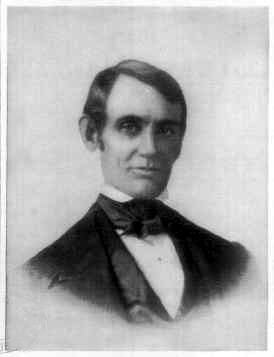On November 4, 1851, Abraham Lincoln wrote a letter to his step-brother, John D. Johnston. Lincoln had become aware that Johnston planned to move from Illinois to Missouri. Lincoln thought this was a poor idea, and he articulated his reasoning in the letter. In this article, I will discuss the letter and the relationship between Lincoln and Johnston.
Who Was John D. Johnson?
My history of Johnston borrows from the Papers of Abraham Lincoln Digital Library webpage on the subject.
Johnston’s widowed mother, Sarah Bush Johnston, married Abraham Lincoln’s father, Thomas Lincoln, on December 2, 1819. As a result, the Lincoln and Johnston families were brought together, and Lincoln grew up with Johnston and other siblings.
Johnston wed in 1834, but his first wife died in 1850. He had been farming in Coles County, Illinois, with his stepfather (Lincoln’s father, Thomas). Johnston married the 15-year old Nancy Jane Williams in March of 1851.
Months later, Lincoln became aware that Johnston planned to move. Lincoln advised Johnston to stay in Coles County and work the farm that Thomas Lincoln had left behind.
Prelude to the November Letter
I found the November 4 letter from Lincoln to Johnston in Speeches and Letters of Abraham Lincoln, 1832-1865 on Project Gutenberg. The collection includes two letters from Lincoln to Johnston.

Ten months before the letter that we will focus on foremost in this article, Lincoln had sent a letter to Johnston on January 2, 1851. From Lincoln’s words, we understand that Johnston had requested financial support from his stepbrother in the amount of $80 (about $2,850 in today’s dollars).
I have prepared a PDF of the letter for your convenience. You can also read it on Project Gutenberg.
Lincoln declined the request, and he explained his reasoning. It was Lincoln’s opinion that, although Johnston was not “lazy,” he was an “idler” who had not put in the work to improve the state of his financial affairs. In lieu of money, Lincoln advised Johnston that he should work “tooth and nail” for someone who would pay for his services. Lincoln proposed only then would he provide his own assistance to Johnston:
I now promise you that for every dollar you will, between this and the first of May, get for your own labor, either in money or as your own indebtedness, I will then give you one other dollar.
Perhaps significantly in light of Lincoln’s November correspondence to Johnston, Lincoln advised Johnston to seek work in Coles County.
Lincoln concluded by noting his concerns about Johnston’s offer that in return for $80, Johnston would deed Lincoln his land:
Nonsense! If you can’t now live with the land, how will you live without it?
Intervening Events
Lincoln’s January 2 letter referenced his father (and Johnston’s stepfather), Thomas Lincoln. Fifteen days later, Thomas Lincoln passed away. As we learned above, Johnston married for the second time that March. These events, taken together, provide context to the November letter.
The November Letter
Before continuing, you can read the November 4 letter from Lincoln to Johnson on Project Gutenberg or in PDF form here at The New Leaf Journal.
Lincoln began his letter by noting that he had just arrived in “Charleston” – here he was referring to Charleston, Illinois, in Coles County. Lincoln stated that upon arriving, he learned that Johnston was considering selling his land in Coles County and moving to Missouri.
Lincoln described Johnston’s idea as “utterly foolish.” Echoing his January letter, Lincoln took the view that Johnston’s problem was that he was unwilling to work rather than where he was situated. “Squirming and crawling about from place to place can do no good.”
Lincoln added his pragmatic concerns about Johnston’s idea to move to Missouri specifically. He noted that Johnson would have to spend much of his limited funds to complete the move, and he would not then have enough left over to buy land to work,
Lincoln informed Johnston that he intended to keep the land that he inherited from Thomas Lincoln in his possession for the upkeep of Johnston’s mother (and Lincoln’s stepmother) so long as she was alive. Lincoln added that he would rent the land if Johnston was unwilling to work it.
Lincoln wrote that his objective was not to be unkind, but rather “to get [Johnston] to face the truth.” “Your thousand pretenses for not getting along better are all nonsense; they deceive nobody but yourself. Go to work is the only cure for your case.”
He concluded by recommending to Johnston that he stay with a gentleman named Augustus H. Chapman, who had told Lincoln that he wanted Johnston to live with him. Lincoln expressed “no doubt that [Chapman] will make [Johnston’s] situation very pleasant.”
After the Letter
Although Johnston did not move to Missouri, he did not heed Lincoln’s advice. According to the Lincoln Library page on Johnston, he tried to start a farm in Arkansas in 1852. That endeavor failed, and Johnston returned to Coles County with his very young wife and newborn son, where he died in 1854. He left behind his 18-year old wife, Nancy J. Johnston and his son with an estate worth $56. (I did not find additional information about them.)
As we know, Abraham Lincoln’s life went in a different direction. Nine years after penning his November 1851 letter to Johnson, Abraham Lincoln won the 1860 presidential election, and was sworn in as the 16th President of the United States on March 4, 1861.